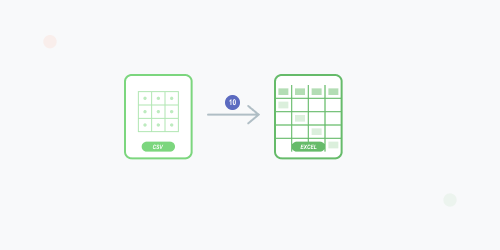Top 10 Uses of a CSV to Excel Conversion Tool

Spreadsheets sit quietly behind almost every task: from tracking sales to organizing research data. Typically, most of that data comes-in CSV format, it is a data format which is filled with plain text and commas. It is a simple file type, but not best to look at or easy for handling when the file holds thousands of rows.
That’s where a CSV to Excel conversion tool turns frustration into clarity. It changes raw comma-separated data into a structured Excel sheet that anyone can read or work on instantly.
Below are ten practical ways such a converter makes daily work smoother.
1. Turning Plain Data into Clean Tables
CSV files look flat and messy — one line after another filled with commas. Once converted to Excel, the same data appears as a clean grid. Columns line up, headings stand out, and everything feels organized. It saves time usually spent fixing alignment or adjusting spacing. Most offices deal with such files every day, and conversion is often the first thing done before any real work begins.
2. Quick Analysis and Sorting
Excel makes it easy to find meaning inside piles of numbers. After conversion, filters and formulas start working like magic. Sorting by date, price, or category takes seconds. It becomes possible to sum columns, calculate averages, or highlight trends that remain invisible inside a CSV file. For analysts or students handling research data, this step is what turns random digits into information that makes sense.
3. Financial Tracking and Budget Work
Point-of-sale systems and finance apps love exporting records as CSV. Converting them into Excel brings those digits to life. Totals can be determined, charts generated, and comparisons drawn without holding a digital tool or calculator. It assists accountants, freelancers, and small business owners for keeping an eye on income as well as spending without juggling raw text files.
4. Cleaning Up Messy or Incomplete Data
CSV files sometimes come with half-filled rows or extra commas that ruin consistency. Inside Excel, that mess can be cleaned fast. Duplicate entries get removed, spaces trimmed, and incorrect values spotted right away. This use might not sound glamorous, but data cleaning often decides whether later analysis succeeds or fails. A converter makes it possible to fix problems before they spread.
5. Marketing Campaign Reports
Digital marketing tools usually export campaign results as CSV sheets — clicks, impressions, conversions. Reading them in text form feels painful. Converted to Excel, those same numbers can be filtered, color-coded, and arranged into charts showing which campaign performed better. Marketers depend on this step to understand where the budget worked and where it didn’t.
6. Product and Inventory Management
E-commerce platforms constantly exchange product information in CSV format. A CSV to Excel converter helps merchants open those files without breaking structure. In Excel, each product’s price, stock count, or SKU sits neatly in its cell. Conditional formatting can turn low-stock items red or mark best-selling products green. That visual clarity saves hours during inventory checks.
7. Collaboration Across Teams
CSV file format is built for machines; Excel is built for individuals. Once the data is transformed, it becomes easy to comment on, protect, and share. Team members can highlight cells, leave notes, or lock sensitive sections. It supports real teamwork, unlike raw CSV lines that no one dares to edit directly. Offices that run on shared sheets prefer Excel for exactly this reason.
8. Building Visual Dashboards
Numbers alone rarely tell a story. In Excel, graphs and pivot charts do the talking. Converting CSV files opens the door to visuals that track performance, growth, or trends. A sales chart, a progress bar, or a revenue pie graph can appear in minutes. Decision-makers often rely on such visuals rather than raw figures, so conversion quietly becomes the first step toward any presentation.
9. Integrating with Business Tools
Plenty of software connects directly with Excel that can range from Power BI to CRM systems. CSV format isn't always perfect for these platforms. Transforming data first ensures full compatibility as well as saves the effort of fixing broken imports later. In addition to that, automation flows run better when MS Excel files are involved as they load structure and formatting that scripts can understand swiftly and easily.
10. Saving Time Every Single Day
Manual formatting eats hours. A good converter turns that pain into a few seconds of waiting. Instead of opening a CSV, aligning columns, renaming headers, and fixing commas, conversion tools do it automatically. Consistency matters most when files repeat daily, such as sales exports or system logs. Those minutes saved daily add up to several hours every week.
Why Choose OCR.ac for Conversion
The CSV to Excel converter on OCR.ac was built for speed and simplicity. Upload a CSV file, wait a moment, and download a structured Excel sheet — nothing else required.
- Works directly in the browser, no software setup.
- Maintains formatting with precision for large datasets.
- Files are deleted automatically right after conversion for protecting privacy.
- Highly compatible with all devices such as phone, tablet, or desktop.
People who are often dealing with data, it becomes the best sources that saves time and effort than expectations.
Closing Thoughts
Every field that ranges from education to finance, based on data that flows daily via CSV files. Reading them directly is tiring, editing them is risky, and understanding them is slow. Conversion into Excel fixes all three problems at once.
A CSV to Excel converter is not just about changing file types; it’s about gaining control. Numbers become readable, editable, and useful. Trends appear faster, mistakes get spotted early, and sharing becomes effortless.